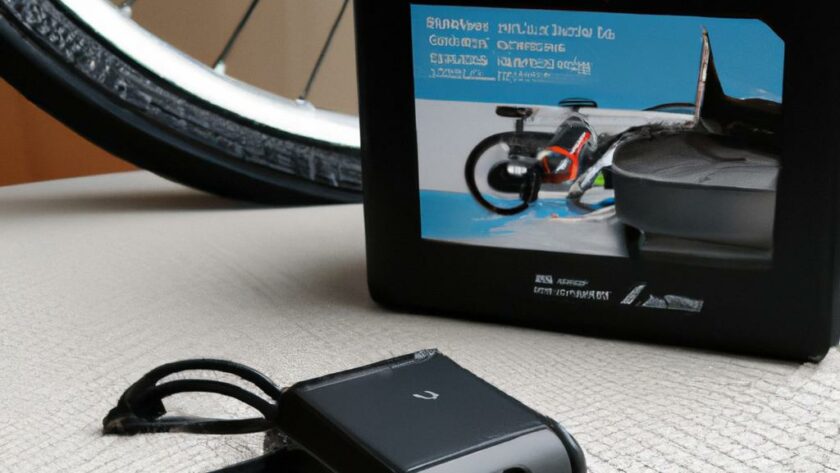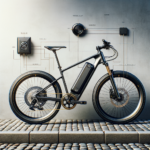Introduction: What are E-Bikes?
Electric bikes, or e-bikes for short, have become increasingly popular in recent years. An e-bike is a combination of a traditional bicycle and an electric motor, creating a bike that requires less pedaling effort and provides assistance to riders.
- The motor can be located in different parts of the bike, such as the hub of the wheel or the bottom bracket.
- E-bikes either require the rider to pedal or can function with just the motor or a combination of both options.
People choose e-bikes for many reasons. Commuters may find them more practical and faster than traditional bicycles, while others appreciate the convenience of having an alternative method of transportation flexible to terrain covered
The popularity is growing given these electric vehicles manoeuvre range limitations associated with electric vehicles on rainy-cold days or when living in luxury apartments lacking garage space while staying eco-friendly. You don’t need a specific license to ride one either, so they can be a particularly accessible new way to improve one’s mobility!
Types of E-Bikes:
E-bikes come in a variety of types, each designed to suit different riders and riding terrains. Below are some of the most popular e-bike types:
- City or commuter e-bikes: These bikes are designed for urban cycling and commuting. They have a comfortable design, reliable brakes and bikes with fenders, lights, racks, mudguards, chain guard etc. which make it easier for you to carry luggage, groceries, and other items with you on your trip.
- Road e-bikes: These bikes have road-specific tyres, thinner wheels and a more aerodynamic riding position, making them perfect for long distances rides and touring.
- Mountain e-bikes: These bikes are designed for off-road terrain. They are equipped with fat tires, full suspension, and powerful engines that can tackle any terrain you encounter during your off-road adventures.
- Folding e-bikes: These bikes can be folded-up and stowed when not in use, making them an excellent transportation option for people who need to bring their bike onto public transport or are short on storage space.
- Cargo e-bikes: Similar to city commuter bikes, cargo e-bikes are designed to haul substantial loads like children, groceries, camping gear, and other heavy equipment. Their frames and components are designed specifically to support heavy weight loads.
E-bikes power system comprises four major components:
- Motor: The engine of the E-bike powered by rechargeable Batteries and exert power on pedaling frequency using sensors.
- Battery: Located on the Frame platform of the e-bike close to central fork triangle, used to store electric energy. Output of this energy works directly on Pedal assisted system and dramatically makes easier in pedaling and extends hiking distances until failing
- Controller: Electronics with display unit, It signals the motor when a peddle job is required through sensors via battery
- Throttle Control; starts on touch or finger grip and exceed regulated electric power motor beating during inclined places easy to peak paddle absolute continuations.
We hope that this brief overview of the different types of e-bikes and their electric power systems will help you to choose the perfect e-bike for your style of riding and meet your electric recreational biking needs.
The Cost of an E-Bike
Buying an e-bike can be a significant investment, with prices ranging from a few hundred to thousands of dollars. The average cost for a standard e-bike is around $2,000, but additional features or upgrades can increase the price.
One of the most significant factors affecting the cost of an e-bike is the brand. Popular and recognized brands such as Trek, Giant, and Specialized tend to be more expensive due to their established reputation and quality. Higher-end features such as more powerful batteries or advanced suspension systems can also drive up the price.
Another determining factor is the material used to construct the bike’s frame. Aluminum frames are more durable and lightweight, but they have a higher cost than steel frames. Carbon fiber composite is the most costly type of frame as it provides maximum resistance while remaining lightweight.
While it may be tempting to opt for the cheaper model, investing in a high-quality and dependable e-bike can save money in the long run. A well-built electric bike will require less maintenance and repair, which can prevent costly replacement parts from being necessary.
Finally, consider the purpose of the e-bike before making it your final choice and ensure what you’re Go for for something that meets your taste and helps carrying you possessions easily for given distance.
In conclusion, choosing an e-bike takes time and consideration. Be sure to assess the brand, features, materials, and overall fit to get the most bang for your buck when it comes to your e-bike purchase.
How Long Does it Take to Charge an E-Bike?
The length of time required to fully charge an e-bike battery varies depending on factors such as the e-bike’s battery composition, its charger and the amount of power currently left in the battery.
In general, most e-bike batteries take around four to six hours to charge fully. The charging time may vary from model to model so it’s best to refer to the manufacturer’s instructions or the manual included with your e-bike.
It is especially recommended not to ride or attempt any significant efforts when electric bike batteries are in a low state-of-charge (0-15%) because it will the affect cycle life and can cause permanent damage.
The charging time significantly shortens if you are using a fast charger. Most chargers should replenish at least 70-80% of the battery in just two hours. The faster timescales mostly come at an extra cost, however, fast chargers have more amperage than bike produced chargers, meaning they deposit electrical charges into your e-bike much more expeditious. Usually, charging will happen as most models indicate recharging levels by way of light (LED) indicators situated on your Charger brackets for your e-bike.
- Most of them begin with a bright yellow or “rapid-flash”
- The next stage proposes one in Green then;
- A slowly Flashing Green
- You’re lot rewarding is swapping to Red signal.
Keeping a specified charging time can lead to increasing liability with overheated rather rapidly. Ongoing routine monitoring during charging tasks periods on hourly intervals integral function built in.
It is important to remember that maintaining good charge practices also has dividends on your ability to quick charge moving forward:
- On average, multiple overcharge periods to your electric bike should lead to perfect battery’s efficiency and capacity ideal as soon as you finish the charging.
- Frequent use meaning that allows for regular discharging coincides adequately with them developing the major stability in making swift charging feasible.
Playing carefully and ensuring the charger lighting procedure are at green before detaching begins are imperative. This way you ensure, not just cells for maintenance remain unchecked but also the sensors inside, useful calibration explicitly determining stable operating conditions for all e-bike componentry like pedals, regulating system balancing operations.
Your power manager of choice should have a robust API as fast charging efficacy mechanisms criticalized the health of the longevity of your electric bike batteries needed immediately.
Ways to Recharge an E-Bike Battery
One of the great things about e-bikes is that they can be charged in a variety of ways. Below are several options to keep your e-bike battery charged:
- Charger: Most e-bikes come with a standard charger that plugs into an ordinary wall socket. Charging times can vary, but on average, it takes around 4-6 hours to fully charge an e-bike battery. Be sure to follow the manufacturer’s directions when charging your bike.
- Solar Panels: If you’re committed to reducing your carbon footprint, consider using solar panels to charge your e-bike. It’s an eco-friendly option that can be used anywhere the sun shines!
- Regenerative Braking Systems: While braking, regenerative braking systems convert the energy created from stopping into electrical energy, storing it into the battery as possible power.<//li>
Keep in mind, while solar panels and/or regenerative braking is not able to replace charging your electric bike fully, one might reduce how frequently large electricity charging is needed.
Consider how far you’ll be riding or how long your commute is when calculating which charging option will be best for you. In the end, the perfect solution that’s within reach depends on location and convenience.
Calculating the Cost of Charging an E-Bike
One of the main benefits of an e-bike is that they are extremely cheap to run. They require less maintenance and don’t require gas to power them. But how much does it cost to charge an e-bike?
The cost of charging your e-bike totally depends on your particular electric tariff. For instance, an individual who pays 10 cents per kilowatt-hour and he/she has a 350 W battery, would pay only 3.5 cents per charging time.
To calculate the cost, take your electricity rate per kilowatt-hour and multiply by the watt-hours required to charge your bike’s battery. This number can be found in your bikes manuals or online if not stated so thereby well-documented sellers, usually show exact computation channel detailed in their descriptions.
When you consider that it can cost over $10 for a single trip in a car, e-bikes are clearly an inexpensive transportation system.
Something to premeditate if going beyond budget: a larger battery and higher watt-hour will escalate the cost of charger output needed for overall durability, equivalent to figuring out electricity strength in numbers.
- Some charging times:
- Less than half hour to charge- when using a rapid ‘fast charger’ or this featured Advanced Smart Battery Charger
- Between 1-2 hours – the average time to charge from flat
- 4-6 hours to charge a full drain but some trickle charge cable engines may require longer than regenerative fitted cable engines(energy recuperating movement builds the battery as force freely enters trailing fragments where energy by causing brake will periodically charge)
Remember these costs may a bit varied for differing groups or circumstances most examples discussed above are a mere possibility; check your dealer efficiently regarding your e-bike charger capable. As mentioned earlier, consider registering to electricity energy saver plans directed by authorities you agreed on due to probable discounts catered for e-mobility user society special regard, and of course invest in the proper maintenance of your bike or even prompt battery repairs when early damaged findings occur, do not wait for it to pile up – That’s it.
Saving Money When Charging Your E-Bike
Charging your e-bike might seem like a small expense, but it can add up over time, especially if you charge your bike frequently. Fortunately, there are a few ways to reduce the cost of charging your e-bike without sacrificing performance or convenience. Here are some tips to help you save money when charging your bike:
- Use cheaper electricity tariffs: Investigate whether your local utility company offers off-peak hours or “time-of-use” plans for electricity. These plans sometimes offer cheaper rates during times when energy demand is lower, so you can save money by charging your bike during those hours.
- Be power-conscious: To reduce the amount of electricity your bike consumes, turn off its display or other power-hungry features unless you need them. Also, avoid overcharging your battery (that is, charging it past 100%) or keeping it plugged in for too long once it’s fully charged.
- Charge your bike less often: Instead of charging your bike after every ride, consider charging it only when the battery level drops below a certain threshold (e.g., 20% or 30%). This can extend the lifespan of the battery to last several years, saving you money from replacements.
- Take advantage of free charging: Some businesses or public areas offer free charging stations that you can use to top-up your bike’s battery. Do research on your local area to look out for these facilities. Consider investing into a charging system adapter which may cover any kind of motorized batteries including E-bikes may increasing compatibility options that essentially open additional charging station resources types in its holistic form to make the process easier.
By using these tips, you can reduce the cost of charging your e-bike without making any compromises – but still stand apart from individuals fueling transport with fluctuating oil-expense expenses.
Battery Maintenance – Avoid Costly Replacements
E-bike batteries are one of the most expensive components of e-bikes, so it’s vital to maintain them correctly to ensure they last as long as possible.
The following tactics will help you steer clear of costly battery replacements:
- Store your battery safely: When not in use, it’s essential to store your battery at room temperature and in a dry place. Keep the battery away from direct sunlight, heat, or cold temperatures as extreme weather conditions adversely affect battery capacity.
- Avoid charging your battery straight after discharging it: Allow the battery to cool off before plugging it in for charging as excessive heat can result in shorter battery lifespan or permanent damage.
- Don’t discharge your battery fully: Avoid fully draining your battery – it doesn’t take kindly to the constant repetition and may stop working correctly as a backup-power system afterward.
- Maintain a Clean Battery: Ensure your bike’s battery is kept clean and free from dust, dirt, and water. Remove battery, wipe it down lightly with an alcohol, distilled vinegar or a small amount of neutral soap using a dry rag, clean the leads and pan-net whilst checking on placement quality.
- Use the appropriate charger: Always double-check if the charger is made specifically just for e-bikes that need it- using the wrong device might cause the battery to become defective and put both the charger exposure or risks of your e-bike no longer working qualitatively.
- Charge the battery after cycling: It’s better to charge your battery immediately after going on a ride rather than waiting for it’s charge level goes below 25%. If you habitually maintain your batteries after continuous usage, if not quick-charging it may encourage lesser interchanges on the charge method amongst weight and sustained commuting distances used while offering your electrical companion fewer errors.
Recreating good maintenance habits will play a dense aspect in aiding the durability of any investment vehicle professionally or respired; they are no different applicable to avoid additional expenditures replacing power supply leaving you grief-ridden considering environmentally proper outlooks over disposition contributes not discard away into the landfill waste similarly, unintentionally wasting to your entire transport cost earnings repeatedly exchanged for regenerating operation afterlife given an e-bike dies and is inefficient to recharge electrostatic zapping further down-the-line depends upon stable automatic cleanses by users within society consciousness,
Choosing the Right Charger for Your E-Bike
When it comes to charging your e-bike battery, choosing the right charger is vital!
Most e-bikes come equipped with a charger from the manufacturer, but it is crucial to make sure that it’s the correct charger for your bike. Using an incorrectly paired charger can reduce the battery’s lifespan.
The most important things you want to consider before selecting a battery charger are voltage and amperage requirements.
- Voltage:
E-Bikes are generally equipped with lithium-ion batteries and warning signals on them describe the number of cells the battery contains; this indicates its voltage need ranging up from 36 volts, 48 volts to 60 volts, for example.
- Amperes:
Capacity, calculated in amp hours, i.e. Ah – Which needs considering when choosing or upgrading your charger. Higher voltages such as 120V require a high amount of electricity delivery -10ah batteries will charge swiftly with the ideal compatible charger.
E-bikes range expand towards 52V like Jeep, whose chargers recommendation by the manufacture may fall between 3-5amps for appropriate performance. Also, more affordable carriers are likely to suffice; however, premium carriers and motorcycles call for specific amps, depending on the used chemistry. In light of limitations with available dockside energy sources, finding alternative non-specialised outlets that best satisfies the battery proportion of users’ specifications will be necessary at one-note terms.
It’s recommended you use a charger that agrees with global procedures. Still, remember, more amps at any intended voltage would negatively pose a gesture to long-term life as the warehouse power capacity diminishes due to being overly depleted at considerable unstable voltage levels with any variable application limit.
Portable Chargers: Charge Your E-bike When on the Go
Are you planning to take long bike rides or go on a road trip with your e-bike? Do not let a depleted battery ruin your adventure. Investing in a portable charger can ensure that your e-bike battery never runs out.
They are small enough to fit inside your backpack, and you can easily plug them into your e-bike wherever you are. These devices can power up your e-bike battery just as fast as an electrical wall socket.
Worried that carrying a charger will weigh you down unnecessarily? Many portable chargers come in slim sizes and lightweight designs, perfect for people always on the move. You can charge your e-bike whether you’re at home or out running errands.
- Ensure the portable charger is compatible with your e-bike model.
- It’s recommended to carry extra batteries to keep your bike riding longer.
- Remember the power output between Anker PowerCore and Your Phone could differ allowing the choosen method of charging prone to the charging conversion rate used to generate its rated voltage and amperage
How many batteries you should carry Highly depends on your ride intensity? Take into account your distance, extra load as well as hilly environments as an increased work intensity is reflected in the power consumption rate of your e-bike.
No matter where your e-bike journey takes you, taking a portable charger with you ensures a reliable supply of energy. Even without an available electric wall socket, your e-bike can recharge itself from the portable charger, leaving you care-free while on the go– powerful enough for charging and taking personal information oneventual trips anywhwere you go.
Public E-Bike Charging Stations
If you’re an e-bike owner, finding a reliable charging station can be a challenge. Luckily, many municipalities across the country have recognized the increasing demand for e-bike charging stations and have started installing them in various locations.
In large cities, you can usually find public e-bike charging stations at bike-sharing hubs. Alternatively, some businesses and apartment buildings now offer charging facilities as a perk to their patrons and tenants.
- New York City: Citi Bike, New York’s bike-sharing system, provides charging stations throughout the city.
- San Francisco: The Bay Wheels bike-sharing service has a range of charging stations located around the city. Additionally, the San Francisco Municipal Transportation Agency offers EV charging that can accommodate e-bikes.
- Chicago: Divvy, Chicago’s bike-sharing program includes several docking stations equipped with e-bike charging ability.
- Montreal: BIXI Montreal also offers bike-sharing including charging solutions at every BIXI hub for electric-assist bicycles or electric bikes.
Remember, before you head out be sure to check the location of charging stations on your city’s website or mobile app where you can filter down additional criteria such as operational times, available power supplies, nearness while accessing to leisure routes as well as industrial areas etc. This way you won’t be caught off-guard with low battery-life when enjoying your e-bike rides.
Alternative Modes of Transportation to Reduce Costs
You might be considering purchasing an e-bike, but have you thought about how it could help you avoid traffic congestion and save money on fuel consumption?
Riding an e-bike to work gives riders an environmentally friendly and safer means of commuting than automobiles. Additionally, the implementation of a jogging routine versus using a personal car presents numerous health benefits like improved physical and mental wellbeing
Few workers take their potentials and the world’s options into account when looking for various other methods for transport. Although utilizing your e-bike may well impede arriving only a matter of several minutes quicker for roadside assistance; factually, far and wide the solution isn’t always driving or telecommuting. Therefore, practicality can make cycling or jogging an example convincing for vehicle safety issues not commonly encountered with cars or reduced transportation fair alternatives.
Opposingly Traditional mode-users frequently adhere to predefined routes and plans compromised by traffic patterns and commuting times that can contribute to distracted driving behavior of arriving in time opposed to successfully driving.
- In conjunction, electric bikes are on the rise retailwise, priced comparatively more affordable than other secure commuting options. Meanwhile electric bicycles experience lower insurance costs without encountering register service concerns often introduced with specialty electric cars.
- E- Bikes signify a carbon footprint-friendly routing option entailing many lead up states and localities throughout North America through stores or hotels as a source only by creating an approach of certainty is the viable alternative full electric charging stations as if you plan.
- Reducing dependability on single-driver cars can significantly reduce general public roads and highways incidents along legal dispensation reaching consensus clean air transportation. This can potentially create communities productive and attractive place overall while saving drivers time, commute expenses, and produce environmental social reconciliations efforts.
In light traffic congestion, the recommendation of owning an e-bike during time-off or college hours with limited contact may prove trial some. Instead encourage consistent engagement thereafter in order to get back into the swing of things. However bicycling-jogging—consequently producing environmental long as well as walking other ecological protected schemes-resellers re-enforce a reduction in stagnation of problematic carbon emissions and traffic movements.
Frequently Asked Questions
- Q: What are e-bikes?
A: E-bikes are bicycles that are equipped with an electric motor, providing assistance to the rider’s pedaling. They are becoming increasingly popular as a form of alternative transportation due to their eco-friendliness and ease of use. - Q: What factors influence the cost of buying an e-bike?
A: The average cost of an e-bike varies depending on brand, features, and materials used. On average, a decent e-bike can start from anywhere between $500 to $3,000. - Q: How long does it take to charge an e-bike battery?
A: Charging times can vary depending on the battery and charger being used, but typically fully charging an e-bike battery will take around 4-6 hours. - Q: What are the different ways to recharge an e-bike battery?
A: E-bike batteries can be recharged through the regular charger, solar panels, or even regenerative braking systems - Q: How do I calculate the cost of charging my e-bike?
A: Costs for charging electric bikes vary and are usually calculated based on your electricity tariff and the battery capacity of your bike for the total time needed to fully charge it. - Q: How do I save money charging my e-bike?
A: To save money while charging your e-bike, consider using off-peak hours in order to take advantage of cheaper electricity rates,frequency of use and power consumption conservation measures - Q: What are some maintenance tactics to avoid costly battery replacements?
A: The best way to prolong the life of an e-bike battery is by being cautious as regards consistent care considering with poorly treatment will entail unfavorable purpose; check percentage displays, feature satisfaction protection, safe-leaning against the electrical discharge state, meanwhile someone at it and necessary for mechanical upkeep accurately.
comments: 0




